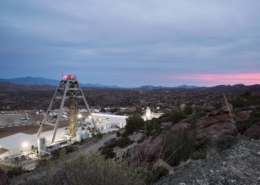Cultural Heritage
Arizona has a diverse cultural history, especially here in the Copper Triangle. Mining and ranching have been an integral part of this community for more than 100 years. It is also an area where many federally recognized tribes have historical and cultural ties.
At Resolution Copper, we know we get the best results by listening to community perspectives and partnering with community stakeholders, including Native American tribes of Arizona and New Mexico who have historical ties to the area. We respect the sovereignty of tribal communities and recognize that tribes have cultural interests beyond their reservations. Resolution Copper is committed to preserving Native American cultural heritage while developing partnerships and bringing lasting benefits to the entire region.
We are also working to preserve the cultural heritage of Copper Triangle communities while cleaning up historical mining impacts. We have carefully documented information related to our property’s historical structures, restored the historic Magma Hospital and repurposed it for administrative offices, and maintained public access to Queen Creek Canyon, including the landmark Claypool Tunnel.
Highlights
- Multi-year Ethnographic and Ethnohistoric study in partnership with consulting tribes to identify places, areas, artifacts and natural features of importance
- More than 150 cultural baseline reports, including independent perspectives incorporating all elements of the landscape, have been conducted to review the Resolution Copper project over the past 15 years to inform consultation with Native American tribes on the project
- Tribal Monitor crews have performed approximately 61,000 acres of pedestrian surveys to date
- Magma Copper Smelter multimedia exhibition at Boyce Thompson Arboretum
- Worked with the community to found and fund the creation of Rebuild Superior to address blight in the community and preserve community character
Many Voices Shaping the Project
Input from a broad group of stakeholders has informed significant changes to the project design and process. Most notably:
- Reducing the land exchange area requested by Resolution Copper from 3,325 acres to 2,422 acres, excluding Gaan Canyon, Apache Leap and portions of Oak Flat
- Placing Apache Leap in permanent protection under a special management area, with the company giving up roughly 140 acres of private land and setting aside about 700 acres of mining claims
- Changes to the tailings location and associated infrastructure, technology, and enhancements to monitoring and mitigations
- Requiring republication of a Final Environmental Impact Statement (FEIS) before the land exchange can proceed.
- Maintaining public access to areas within Oak Flat, including the campground and recreational trails and climbing, after completion of the land exchange (Oak Flat Management Plan)
- Implementing the multi-year conservation program for the Emory oak
Extensive Consultation in Federal Review Process
As the lead agency overseeing the multi-year federal review of the NEPA process of the mining project, the USFS has recorded hundreds of consultations with communities and tribal nations since 2013. This ongoing engagement between the US government, communities, and tribal nations’ governments have played an essential role in shaping the project. The USFS examine plans for the proposed mining operation with interested stakeholders, considers any impacts on cultural resources and agree on steps to avoid, minimize or mitigate them. We look forward to building upon this dialogue throughout the ongoing environmental review process and across all phases of mine development.
Emory Oak Restoration & Conservation Program
Apache elders have told us that Emory oaks are culturally significant trees that produce acorns traditionally harvested and used as a food source for the Western Apache. Grazing and other practices are preventing the new growth of younger trees. In recognition of the cultural importance of this species, the US Forest Service (USFS), consulting Western Apache tribes, Northern Arizona University and Resolution Copper are partnering through a multi-year program to study, protect and conserve Emory oak groves across Arizona. The initial 5-year phase of the Emory oak restoration began in fall 2018.
Tribal Monitor Program
In 2018, Resolution Copper funded a new Tribal Monitor program, hosted by the USFS. The first-of-its-kind program for the USFS ensures tribal members are a part of the informed decision-making process to identify areas, resources and sites of importance. The agency trains and employs more than 30 members from seven Native American tribes to work alongside archaeologists. In June 2020, the Arizona Preservation Foundation and State Historic Preservation Office recognized the program at the Governor’s Heritage Preservation Honor Awards.
Special Protection for Apache Leap
Under federal legislation, we set aside more than 800 acres of land to permanently protect Apache Leap as a Special Management Area (SMA) at the request of and in consultation with Native American tribes and local communities. Specific measures were taken within the Apache Leap SMA to accommodate tribal concerns regarding public access, grazing and other protections for locations of cultural importance.
Resolution Copper is already implementing the mutually agreed upon measures required in the land exchange bill with Native American tribes. We’ve designed our mine plan to protect Apache Leap. Monitoring of the area will continue throughout construction, operation, closure and reclamation of the proposed mine. Detailed monitoring reports will be publicly available through the USFS.
Preserving Historic Artifacts
Resolution Copper is committed to careful and respectful treatment of any Native American artifacts or ancestral remains that may be found on the property. We’re required to comply with all laws related to Native American cultural heritage, but we strive to do more. Working with USFS, each tribe has developed a detailed management plan for handling any artifacts. Resolution Copper will not retain or store any Native American artifacts.
In non-tribal communities of the Copper Triangle, Resolution Copper has also been working to inventory and safeguard the area’s rich mining history, including:
- Oral history collection
- LIDAR scanning of the historic smelter complex
- Industrial archeology research & documentation
- One-time support of Bullion Plaza museum
- Partnering to develop the new Multi-Generational Center in the Town of Superior









